Gens Una Sumus!
Newsletter #929
August 8, 2020
By Abel Talamantez
Table of Contents
- Chess Clubs from Around the Country
- Fred and Pat Mayntz Memorial TNM
- Blitz Tournament of the Americas
- National Invitational Report
- Online Events Recap
- Mechanics' Chess Social
- Weekly Classes
- Scholastic Online Offerings
- Online Events Schedule
- FM Paul Whitehead's Column
- GM Nick de Firmian's Column
- Submit your piece or feedback
Chess Clubs From Around the Country: An Introduction
The chess club is truly a special place, and we see its importance to those who love to play or follow the game, whether it be casually or more seriously. I have experienced and witnessed how infectious chess can be to those who are truly enthusiasts. It becomes something that stays with them all their lives, and in some cases, becomes a passion that cannot be left behind. When I stopped playing chess at the age of 19, I thought I was done with it. I had played competitively for about six years, achieved an expert rating, and felt I had gone as far as I could go before life stepped in to take my attention away. I returned to chess almost 20 years later and started on a course where it would soon become not just a rekindled passion, but a way of life. One of the things that struck me upon my return aside from the very different landscape of events and organizers was that quite a few of the same people I knew when I played 20 years ago were still playing and being active in the Northern California chess scene. For many of us, whether we do it for fun or if we are "in the business", chess always stays with us, in some form or another.
When I started my own chess company in 2012 called Castling Kids, one of the things that was really special for me through that experience was our weekend class meetings. As opposed to our after-school programs, which of course were all special in their own way, the weekend class was our club, our hub, the place where the devoted come to meet and where we were able to really solidify relationships with the kids as students and parents as supporters. That was our chess club, and that is where those of us that were part of it felt we were at home, among community.
When I came to the Mechanics' Institute in 2018, I recognized just standing in the chess room that there was a profound sense of history among inside those walls. One of the many things that makes Mechanics' Institute special is the importance of preserving and remembering those that have been a part of its history. You become a part of the club, the building, the tradition, and it lives on past you in history. For the last nearly 166 years, the Mechanics' Institute Chess Club has told the stories of generations of players, all with their own tales of chess, of life and of having a central place to gather, socialize, and compete. It is a place where everyone is gathered for the same purpose, all speaking the same language of chess.
As a member of the US Chess Club's Committee, I have had the opportunity to work with others across the country in updating the Guide to a Successful Chess Club and learning what other clubs across the country are doing to build membership and about how clubs operate and the importance of chess clubs in their communities. So many people all across the county work hard to develop their chess clubs, no matter how big or small, because a chess club does more than just offer a place to play, it really provides a social outlet for many, no different from what a community center means to a community.
It is with this spirit and background I will begin writing about chess clubs from around the country and world. I will pick one club weekly and briefly discuss its history, evolution, and where they are today. I have always been curious about how others structure their clubs and the people that make up a club, and I'm hoping I can bring their experience to paper. Stay tuned next week for the first article!
Fred and Pat Mayntz TNM Report
The Fred and Pat Mayntz Tuesday Night Marathon is off and running, as over 60 players have joined and more coming in starting next week. As in our last TNM, the top section was stacked with players, making up over 80% of the field. After the first 2 rounds in the 1600+ section, 12 players go into next week's round 3 & 4 with 2/2, including some of the pre-tournament favorites FM Kyron Griffith, IM Elliott Winslow, and NM Ruiyang Yan.
In the under 1600 section, Pranav Pradeep is the only player perfect thus far with 2/2.
This tournament is 8-rounds USCF online rated, with 2 rounds played per week with round times of 6:30pm and 8:00pm. Ratings are done manually on Chess.com according to each player's standard USCF rating. Because of this, players may request byes for rounds and join the tournament late.
This tournament was named in honor of Fred and Pat Mayntz, who ran the Kolty Chess Club from about 1983-1993. It was the chess club I first started playing at when I was 12 years old in 1985, and they were both very kind and loved the game and the club. The Kolty Chess Club continues to operate today on Thursdays in Cambell, CA, though it is closed now due to the shelter in place order.
If you are still interested in joing the event next week and receiving half point byes for the first two rounds, you may register by following this link: https://mechanics-institute.jumbula.com/2020OnlineTournament/TuesdayNightMarathonONLINEAug2020
To watch the broadcast of the first two rounds, follow this link: https://www.youtube.com/watch?v=Q7Fmzq1GbfI
Standings can be found here: https://www.milibrary.org/chess-tournaments/fred-and-pat-mayntz-memorial-tuesday-night-marathon-online-aug-2020
Here are some games from the round, annotations by GM Nick de Firmian.
(5) PJ Liotino (CocoKat) (1608) - IM Elliott Winslow (ecwinslow) (1943) [A61]
Live Chess Chess.com, 04.08.2020
[de Firmian,Nick]
1.d4 Nf6 2.c4 e6 3.Nf3 [3.Nc3 Bb4] 3...c5 A popular Benoni move order. Black assures White it isn't going to be a Benko (so he'll probably be more likely to play 4.d4-d5). Plus, now Black doesn't have to worry about a lot of annoying lines, like aggressive ones with a quick f2-f4, or for that matter super-solid ones with f2-f3. If White likes those above lines he has to play 3. Nc3, but then he has to worry about the Nimzoindian. [Part of the game plan is that Black wants a more exciting game than might happen in the Queen's Indian. 3...b6 But the QID isn't as tepid as it used to be.; A similar psychology is the Bogoindian, 3...Bb4+] 4.d5 exd5 5.cxd5 d6 6.Nc3 g6 7.Bf4 An old move, even older than first thought, but with a new life. [7.Bg5 is rare these days, but nonetheless annoying for Black.; And 7.g3 remains more than a bit popular, with theory still expanding.; While 7.e4 is the "main line," 7...Bg7 8.h3 (8.Be2 0-0 9.0-0 is the "old" ML) 8...0-0 9.Bd3 and this is the "Modern" ML. 9...b5?! is fine if you're playing a strong (or stronger) grandmaster and happy to get a draw, but for a Swiss System warrior you'll want it a bit spicier, risk and all.] 7...Bg7 [7...a6 used to be at least as popular, see next note.] 8.h3!? White's plan is subversive: Save the bishop (which pressures d6) , avoid any targets (so no e2-e4, at least not until ready), complete development and await -- well, developments. [8.Qa4+!? Bd7 9.Qb3 has been an extremely popular line over the years, but players of Black may have found an adequate antidote. 9...Qc7 10.e4 (10.Bxd6? Qxd6 11.Qxb7 Qb6 12.Qxa8 Qxb2 13.Rb1 Qxc3+ 14.Nd2 0-0!) 10...0-0 11.Nd2 (11.Be2 b5! 12.Bxb5 Nxe4! 13.Nxe4 Qa5+ gets the piece back, with a pretty annoying development lead (king in the center!).) 11...Nh5!? 12.Be3 f5! 13.exf5 Bxf5! (13...gxf5?! 14.Be2 f4 15.Bxc5!! f3 16.Bxf3 Rxf3 17.gxf3!! was Korchnoi schooling Nunn in tactics and opening analysis: 1-0 (41) Korchnoi,V (2635) -Nunn,J (2600) London 1984) 14.Be2 Nf6 and in the latest Benoni analysis (well, in the Doknjas book published earlier this year!) Black was holding his own. But Wesley So showed the level of *his* analysis as well, in St. Louis probably at the same time as this book was being printed: 15.Nc4 (15.0-0; 15.h3) 15...Ne4 16.0-0 Nxc3 17.bxc3 Bd7 (17...Nd7!? is what had been played before, and given by Doknjas in over three pages of work! 18.Bf4 Rf6 (18...Bc2!? 19.Bxd6 Bxb3 20.Bxc7 Bxc4 21.Bxc4 Bxc3) ) 18.Nd2 b5 19.Bxb5 Bxb5 20.Qxb5 Bxc3 21.Rac1 Bxd2 22.Bxd2 Nd7 23.Rce1 Rab8 24.Qd3 Ne5 25.Qe4 c4 26.Bc3 Rbe8 27.Qd4 1-0 (39) So,W (2765)-Sevian,S (2660) PRO League Stage, chess.com INT 2020] 8...0-0 9.e3
 |
This is a very current variation, but also was in ... the 1950s!! 9...Nh5 [9...b6 10.Nd2 Ne8 11.Nc4 Ba6 12.a4 Bxc4 13.Bxc4 Nd7 14.0-0 Ne5 15.Be2 f5 1/2-1/2 (38) Keres,P-Tal,M Tallinn 1954; 9...Ne8 10.Be2 Nd7 11.0-0 Ne5 12.Bxe5 dxe5 13.Nd2 f5 14.Qb3 Nd6 15.Nc4 e4 16.Nb5?! (16.Nxd6 Qxd6 17.Rfd1 Kh8) 16...Nxb5 17.Qxb5 b6 18.d6 Bd7 19.Qb3 b5=/+ and it was that other famous (Benoni!?) player who triumphed! 0-1 (45) Tal,M-Spassky,B Leningrad 1954; Nowadays the key move is 9...Na6! 10.Be2 (10.Bxa6!?; 10.Nd2 Nc7 11.Nc4 b5! 12.Nxd6 b4 could easily become another case of White's king caught in the center.) ] 10.Bh2 f5 11.Be2 Qe7 12.0-0 a6 13.a4 Nd7 14.Nd2 Nhf6 15.Nc4 Ne8 16.a5
 |
Black's opening might just be a failure, in that he's been pushed back and White has a lock on b6. 16...Rb8 17.Qd2 Ne5 18.Nb6
 |
18...Bd7N [18...Nf6 was previously played] 19.Rab1! g5 20.f4 White can proceed immediately: [20.b4! c4 (20...cxb4 21.Rxb4 covers f4) 21.f4 gxf4 22.exf4 Nd3 23.Bxd3 cxd3 24.Qxd3 White is doing well.] 20...Nf7?! [20...gxf4 21.exf4 Ng6 is to be preferred. Now White prepares to attack the kingside in general and the f5-pawn in particular.] 21.Bd3 g4 22.hxg4 fxg4 23.Rbe1 White's center should be the end of Black. 23...Nc7 24.Bg3 Nh6 25.e4 [25.Nxd7 Qxd7 26.e4] 25...Bd4+ 26.Bf2 g3
 |
Black may have thought White had missed something, and in fact he had missed something -- a winning defense! 27.Bxd4 Qh4 28.Rf3 Bg4?
 |
[28...cxd4 29.Ne2 Qh2+ 30.Kf1 Bg4 31.Rxg3 Kh8 32.Kf2 still allows Black to play on] 29.Be3? [29.Rxg3!! Qxg3 30.Bf2! Qxf4 31.Be3! is a nice snapback winning the knight on h6 and the game.] 29...Qh2+ 30.Kf1 Qh1+ 31.Bg1? [31.Ke2! loses a rook but not necessarily the game: 31...Qxg2+ 32.Kd1 Bxf3+ (32...Qxf3+? 33.Kc1 is good -- for White) 33.Kc1 and Stockfish 11 makes this a hard nut to crack.] 31...Bxf3 but now it's bad news for White's king. 32.gxf3 Qxf3+ 33.Bf2 Rxf4 [33...Ng4!] 34.Nd1 [34.Qe3 Qg4] 34...Rbf8?! [34...g2+ 35.Kg1 Qh3] 35.Qe3 gxf2 [35...Qg4! 36.Re2 Qh4 37.Ke1 gxf2+ 38.Nxf2 Rf3] 36.Nxf2 Qxf2+ The game is quite over, butr White plays on from inertia. 37.Qxf2 Rxf2+ 38.Kg1 Rxb2 39.e5 Ne8 [39...Nf7!?] 40.exd6 Nxd6 41.Re6 Nhf5 42.Nd7 Rf7 43.Nf6+ Kg7 44.Nh5+ Kf8 45.Nf6 c4 46.Bxf5 Nxf5 47.d6 Rd2 48.d7 Rfxd7 49.Nxd7+ Rxd7 50.Kf2 c3 51.Re5 Rf7 52.Rc5 Nd6+ 53.Ke3 Nb5 54.Kd3 Kg7 55.Rg5+ Kf6 56.Rc5 Rd7+ 57.Kc2 Rd2+ 58.Kc1 Rg2 59.Rc7 h5 60.Rxb7 h4 61.Rb6+ Kg5 62.Rxa6 h3 63.Ra8 h2 64.Rh8 Na3 65.Rg8+ Kf4 66.Rf8+ Ke4 67.Re8+ Kd4 68.Rd8+ Ke3 69.Re8+ Kf2 70.a6 h1Q+ ecwinslow won by resignation 0-1
(6) Adam Mercado (A-boy415) (1637) - Kevin Sun (kevin_mx_sun) (1469) [E99]
Live Chess Chess.com, 04.08.2020
[de Firmian,Nick]
1.d4 Nf6 2.c4 g6 3.Nc3 Bg7 4.e4 d6 5.Nf3 0-0 6.Be2 e5 7.0-0 Nc6 8.d5 Ne7 9.Ne1 Nd7 10.Nd3 f5 11.Bd2 Nf6 12.f3 f4
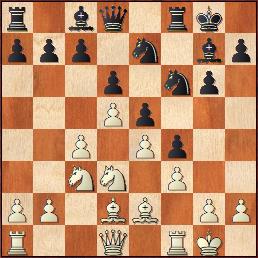 |
The famous Mar Del Plata Variation. The battle lines are fairly clear. White: c4-c5 and break open the c-file; Black: g6-g5-g4 and checkmate! If only it were that simple! White's defense of g4 is pretty good at the moment, while Black's defense of c5... 13.b4?! White wants to be able to recapture on c5 with a pawn, setting up a nice front. But there's just one problem: Black doesn't have to capture, and in fact doesn't under most circumstances anyway. [Therefore, 13.c5! is the right move. White saves a tempo, and in supersharp lines like this a move can be all it takes to swing the whole game in your favor. 13...g5 14.cxd6 cxd6 15.Rc1 Ng6 16.Nb5 Rf7 17.Qc2 Ne8 18.a4 h5 (18...Bf8 19.Nf2 1-0 (45) Toth,B (2395)-Sartori,S Napoli 1981) 19.Nf2 Bf8 1-0 (64) Rashkovsky,N (2505)-Gufeld,E (2525) Daugavpils 1978 20.a5 Rg7 21.h3 Nh4 1-0 (45) Toth,B (2395)-Sartori,S Napoli 1981; 13.Rc1 g5 14.c5 Ng6 15.Nb5 (15.cxd6) 15...Ne8 16.Qc2 Rf7 17.Nf2 Bf8 18.b4 h5 19.a4 Rg7 20.cxd6 1-0 (35) Hirneise,T (2421)-Arvola,B (2218) Caleta 2010] 13...g5 14.c5 Rf7 Attack and defense. c7 is the weak point after the c-file opens, so Black is thinking of covering it while at the same time setting up ...Bf8 and ...Rg7. [14...h5 looks to get in ...g4 right away;; The grounds for 14...Ng6 isn't so cut and dry. There is a principle: save your options. So here Black isn't entirely sure his rook wants to step up. But on the other hand, there is an option of ...Kh8 and ...Ng8-h6. Why is this so much more popular? It's unclear.] 15.cxd6 A similar concept is at play here. [15.Rc1 is played far more often, and in fact, is the only move that hasn't lost every game! It also doesn't open up the possibility of ...Qb6+.] 15...cxd6 16.Rc1 [16.Nf2 is the only move played previously, with no score.] 16...h5 This probably is okay, although Black has to worry about White's play down the c-file still. [16...Ng6 17.Nf2 h5 18.Nb5 Bf8 19.Qc2 0-1 (56) Wolf,G (1629)-Faldum,M (1923) Frankfurt 2012; 16...Bf8] 17.Nb5 Ng6 18.Qc2 g4!? [The only game here went 18...Ne8 The threat was 19.Nc7 Rb8 20.Ne6! Another principle is that it will be hard for Black to break through without the light-squared bishop. But note that the pawn on b4 takes that square away from White's knight, should there be a later 20...Bxe6 21. dxe6. 19.Nf2 Bf8 20.a4 (20.Nxa7 Rc7 0-1 (56) Wolf,G (1629)-Faldum,M (1923) Frankfurt 2012) 20...Rg7 21.Nxa7!? (21.a5 Nh4 22.h3 a6 23.Na3 Nf6 (23...g4 24.fxg4 Nf6 1-0 (45) Toth,B (2395)-Sartori,S Napoli 1981) 24.Be1 g4 is still a complicated situation as Black's attack reaches perfect storm level. 0-1 (52) Ager,J (2109)-Hoellrigl,W (2204) Austria 2017) 21...Rc7 22.Nc6 bxc6 23.dxc6 White has sneaked in a2-a4 "for free" and has won here twice! 23...g4 24.fxg4 Nf6 (24...hxg4 25.Bxg4 Qh4 26.Qb3+ Kh8 27.Bxc8 Raxc8 28.b5 1-0 (35) Hirneise,T (2421)-Arvola,B (2218) Caleta 2010) 25.gxh5 Nh4 26.g3 Rh7 27.b5 1-0 (64) Rashkovsky,N (2505)-Gufeld,E (2525) Daugavpils 1978] 19.Nc7 Rb8 20.Be1 [20.Ne6!? Qe8!? 21.b5! keeps an initiative burning for White while Black doesn't have any particular threats. Taking either pawn give White plenty of compensation.] 20...gxf3 21.Rxf3? Now Black is getting some momentum. [21.Bxf3 Bg4 lets Black live with the knight at e6, until he gets ...Nf8 in to push it out.] 21...Bg4 22.Ne6 Qe7 [22...Qe8!] 23.h3?! Black probably won't need encouragement, but it is nice to get the bishop to commit.. . 23...Bxf3 24.Bxf3 Bh6
 |
[24...Qd7!] 25.Qe2? Nh4?? A disaster ruins an exciting and excellent game! One suspects that the players just ran out ot time and started blitzing. [25...Nf8! leaves Black an exchange up with a won game.] 26.Bxh4 Qe8 27.Bxf6 [27.Bxh5!] 27...Rxf6 28.Rc7 Qb5 29.Bxh5 Rxe6 30.Qg4+ Kh8 31.Qxe6 Qb6+ 32.Kh1 Qxc7 33.Qxh6+ Qh7 34.Qf6+ Qg7 35.Qxd6 Rg8 36.Qxe5 Qxe5 37.Nxe5 Rg5 38.d6 Rxe5 39.d7 Rxh5 40.d8Q+ Kg7 41.Qc7+ Kf6 42.Qxf4+ A-boy415 won by resignation. Far from perfect, but a typical rough and tumble Mar Del Plata King's Indian. This siren line continues to lure grandmaster and club player alike to treasure and shipwreck. 1-0
(7) NM Ruiyang Yan (jij2018) (2148) - Adam Mercado (A-boy415) (1636) [B31]
Live Chess Chess.com, 05.08.2020
[de Firmian,Nick]
1.e4 c5 2.Nf3 Nc6 3.Bb5 [3.d4 cxd4 4.Nxd4 Nf6 5.Nc3 e5 6.Ndb5 d6 was the later "surprise" in the World Championship 2018 match, when Caruana played 7.Nd5!? Nxd5 8.exd5 over and over again, with all sorts of new ideas. But no wins!] 3...g6 4.Bxc6 This committal but unbalancing capture has been gaining ground in popularity, not the least because Caruana dropped it on Carlsen in their World Championship match a couple times (Games 1 & 3) [before switching to 4.0-0 in Game] 4...bxc6 [4...dxc6 is more frequently seen (certainly by Carlsen!), but it's more a matter of taste than correctness.] 5.0-0 Bg7 6.Re1 d6 [6...e5; 6...Nf6 7.e5 Nd5 8.c4 Nc7 9.d4 cxd4 10.Qxd4; 6...Nh6!? is the Big Theory move -- planning to overrun the center after ...f5 next.] 7.h3 [7.c3 Bg4 hinders White's expansion] 7...Rb8 8.c3 e5 9.d4 cxd4 10.cxd4 exd4 11.Nxd4 Ne7 12.Nc3 0-0 13.Rb1 Qa5?! The opening was about equal before this. Black needs to take care of his pawns. 14.Be3 a6 15.Qd2 Re8 16.Nb3 Qb4 17.Bf4! Be5 18.Bxe5! dxe5 19.Qe3
 |
White sets up a classic lock on c5 with the knights. The lack of dark square control means that Black just never gets much play. 19...Be6?! 20.Nc5 Bc8 21.a3 Qb6 22.b4! Rd8 23.Rbd1 Bb7 A sad move to make as the bishop has no scope. It's hard to play the black side here. 24.Qg5 a5? losing a piece but life was very tough here anyway 25.Qxe7 axb4 26.N3a4 Rxd1 27.Rxd1 Qb5 28.axb4 Qxb4 29.Qxe5 Bc8 30.Rd8# jij2018 won by checkmate. Ruiyang is filling in the gaps and becoming a seasoned competitor. 1-0
(8) Eric Smith (edoctorsmith) (2021) - Ashik Uzzaman (ashikuzzaman) (1859) [A01]
Live Chess Chess.com, 05.08.2020
[de Firmian,Nick]
1.b3 f5 2.Bb2 e6 3.e3 Nf6 These are two players who are going to play what they want no matter what! 4.d4 It's hard to make sense of this, since the dark squares seem to be in control of White already. 4...Be7 5.Nf3 0-0 6.g3 White is swimming around for a purpose, but each move helps to control the center. 6...d6 7.Bg2 Nc6 8.0-0 Qe8 9.c4 Ne4 Now it's starting to look like the real thing. Black is thinking ...Bf6 and sure enough, the dark squares are contested with ...e5. Perhaps Black could play more calmly, [Say, 9...Bd7; or even 9...Bd8] 10.Nc3 A new move; [10.d5 Nd8 11.dxe6 Nxe6 12.Nbd2 N6c5 13.Nxe4 fxe4 14.Ne1 Qg6 15.b4 Bg4 16.Qd2 Na4 17.Ba3 Be6 18.Qc2 Qf6 19.Rc1 Nb6 20.Bb2 Qf7 21.Bxe4 Nxc4 22.Bxh7+ Kh8 23.Bg6 1-0 (29) Muench,U-Hartmann Frobenius,A, Bayern-chA (Women) 61st, Vorra 1990] 10...Nxc3 11.Bxc3 Bf6 12.Rc1 e5 13.d5 Nb8 14.Qc2
 |
14...f4? Black hits the gas while undeveloped. Often a formula for disaster. [14...Qh5 followed by ...Nd7 was preferable.] 15.exf4 There follows a long sequence of exchanges, leaving Black in a mess. 15...exf4 16.Bxf6 Rxf6 17.Rfe1 [17.Rce1! Qh5 18.h3! catches Black stumbling. 18...Bxh3?! 19.Bxh3 fxg3 (19...Qxf3 20.Re8+ Kf7 21.Rfe1; 19...Qxh3 20.Ng5 Qh5 21.Re8+ Rf8 22.Rxf8+ Kxf8 23.Qf5+ and mate) 20.fxg3! Rxf3 21.Rxf3 Qxf3 22.Re8+ Kf7 23.Bg2! Qg4 24.Rh8] 17...Qh5 18.Qe4 fxg3 19.hxg3 Bf5?! Black should try [19...Bd7 or; 19...Bg4] 20.Qe8+ Qxe8 21.Rxe8+ Rf8 22.Rxf8+ Kxf8 23.Nd4 Bd7 24.Re1?! White keeps more of an advantage with [24.b4 or; 24.c5!? dxc5 25.Ne6+ Bxe6 26.dxe6 c6 27.Rxc5 Ke7 28.Rf5! Kxe6 29.Rf8] 24...Na6 Black is trying to survive, finally bringing out the queenside. But he has to be careful, and isn't. 25.a3 Re8 26.Rxe8+ Kxe8 27.b4 b6?
 |
Now White puts it away. 28.Nc6! Bxc6 This must be played as losing the a-pawn isn't a saving option. 29.dxc6 The game is over. The knight is buried. 29...Nb8 30.f4 a6 31.b5 axb5 32.cxb5 Ke7 33.Kf2 Ke6 34.Be4 h6 35.Ke3 g5 36.fxg5 Keeping passed pawn options on the kingside would have made it a bit easier, but deprived us of a nice finish. 36...hxg5 37.Kd4 Kf6 38.g4 Kf7 39.Bd5+ Kf6 40.Ke4 Kg6 41.Bc4 Kf6 42.a4 Kg6 43.Be6 Kf6 44.Bf5 Kf7 45.Kd5 Ke7 46.Bc2 Kf6
 |
Black has been keeping the White king out, but: 47.a5! bxa5 48.b6! cxb6 [48...Nxc6 49.Kxc6 cxb6 50.Kxd6 b5 51.Bd3 b4 52.Bc2; 48...Na6 49.Ba4! Nb4+ 50.Ke4 Nxc6 51.Bxc6 cxb6 52.Kd5 Ke7 53.Ba4] 49.c7 Na6 50.c8Q edoctorsmith won by resignation. 1-0
(1) Ian Liao (victor6688) (1227) - Pranav Pradeep (pranavpradeep2006) (1144) [C07]
Live Chess Chess.com, 05.08.2020
1.e4 e6 2.d4 d5 3.Nd2 c5 4.Ngf3 Nc6 5.Bb5 Bd7?! [Black could equalize with 5...cxd4 6.Nxd4 Bd7] 6.c3 [6.exd5! exd5 7.0-0 would give White a nice lead in development in a now open position] 6...a6 7.Be2 Qb6 8.Nb3?! c4?! [8...dxe4 9.dxc5 Bxc5 10.Nxc5 Qxc5 11.Be3 Qf5 is an edge for Black] 9.Nbd2 Nf6 10.e5 Ng8 11.0-0 Nge7?!
 |
12.b3 [White has a nice shot here - 12.Bxc4! dxc4? 13.Nxc4 Qc7 14.Nd6+ Kd8 15.Nxf7+ Ke8 16.Nxh8] 12...cxb3 13.Nxb3 Nf5 14.Qd2 These next few moves by White are a little slow, giving time for Black to develop. [14.a4 taking queenside squares and planning to exchange dark squared bishops with Ba3 would be good for White] 14...Be7 15.Bb2 0-0 16.Rab1 Rac8 17.Rfe1 Na5 18.Nxa5 Qxa5 19.Rec1 b5 [19...Bb5! 20.Bxb5 axb5 trades off Black's bad bishop in the French Defense. Black would have a strategic advantage after that. 21.c4] 20.a3 Rc6 21.Ra1 Rfc8 22.Bd1 R6c7 23.a4? This is the source of all White's trouble in thie game, giving away a pawn which soon becomes very powerful. 23...bxa4! 24.Ra2 a3 25.Rc2? White was in trouble before this, but now loses a piece with this move. 25...Ba4 [25...axb2 26.Rxa5 b1Q is also good] 26.Rc1 axb2 27.Qxb2 Rc4 28.Qb7
 |
28...Qb5! neatly solving all the problems of the pin on the a4 bishop 29.Qa7 Bxd1 30.Rxd1 Rxc3 31.Rxa6 Rc1 32.Ra1 Qb2 33.h3 Rxa1 34.Rxa1 Rc1+ 35.Rxc1 Qxc1+ 36.Kh2 g6 37.g4 Qf4+ 38.Kg2 Nh4+ 39.Kf1 [39.Nxh4 Bxh4 is equally hopeless] 39...Nxf3 40.Qxe7 Nxd4 41.Qf6 Qxf6 42.exf6 White is done for. The rest requires no comment. 42...Nb3 43.Ke2 Nc5 44.Ke3 Nd7 45.g5 Kf8! remembering to get the king in the game 46.Kd4 Ke8 47.f4 Kd8 48.h4 Kc7 49.Kc3 Kd6 50.Kd4 e5+ 51.fxe5+ Nxe5 52.Ke3 Ng4+ 53.Kd4 Nf2 54.Ke3 Ng4+ 55.Kd4 Ke6 56.Kd3 Ne5+ 57.Ke3 Nd7 58.Kf4 Nb6 59.Ke3 Kf5 60.Kf3 d4 61.Kg3 Ke4 62.Kf2 d3 63.Ke1 Nc4 64.Kd1 Ke3 65.h5 gxh5 66.g6 hxg6 67.Ke1 d2+ 68.Kd1 Nb2+ 69.Kc2 d1Q+ 70.Kxb2 Kd3 71.Ka3 Kc3 72.Ka2 Kc4 73.Kb2 Qd2+ 74.Ka3 Qc3+ 75.Ka2 h4 76.Kb1 h3 77.Ka2 h2 78.Kb1 h1Q+ 79.Ka2 Qh2+ 80.Kb1 Qe1# checkmate - good technique by pranavpradeep2006 after he got the advantage. 0-1
(2) Pranav Sairam (chesspilot01) (1997) - Saatvik Krishnan (saatvik1) (1742) [B07]
Live Chess Chess.com, 04.08.2020
1.e4 d6 2.d4 Nf6 3.Nc3 c6 4.Nf3 Bg4 5.h3 Bh5 6.Be2 e6 This opening strategy by Black has a logic to it. The light-squared bishop develops outside the pawn chain and Black sets up a defensive front on the third rank. White has a freer hand in the position and thus an edge, but it takes patience to make use of it. 7.Be3 Be7 8.Qd2 This queen move is not so useful here. [8.0-0 d5 9.e5 Nfd7 10.Ne1 saves a tempo] 8...0-0 9.0-0 d5! 10.e5 Nfd7 11.Ne1 Bxe2 12.Nxe2 c5 The opening is equal now. It is a French Defense with the light-squared bishops exchanged. 13.c3 Nc6 14.f4 Qa5 15.Qd3 Rac8 16.a3 cxd4 17.cxd4 Nb4?! [17...Qa6 18.Qxa6 bxa6 would be a good plan. The doubled a-pawns don't hurt Black as there is play on the b-file. Black is happy to get to an endgame where the king is safe.] 18.Qd1! Nc6 19.Nd3 f6 20.g4 [20.f5! exf5 21.b4 Qa6 22.Nef4 gets an active position. e.g. 22...fxe5 23.dxe5 Ndxe5 24.Nxe5 Nxe5 25.Qxd5+ Nf7 26.Qxf5] 20...g6 21.exf6 Bxf6 22.Ne5 Ndxe5 23.fxe5 Bg7 24.Nf4 Rce8?! [24...Bh6! gives Black more active possibilities.] 25.Qd3 Rf7 26.h4 Preparing to storm the kingside. [26.Rf2 Qc7 27.Raf1 builds up on the kingside with piece play] 26...b5? This is too slow. Black needs to hit back on the kingside squares - [26...Qd8! 27.h5 Qh4! is enough counterplay to hold the balance] 27.h5! g5 This isn't good but Black had no decent move. The loss of one tempo on move 26 was critical. 28.Nh3 Rxf1+ 29.Rxf1 h6 30.Qg6 The black kingside is swiss cheese - full of holes. 30...Re7
 |
31.Bxg5! hxg5 32.Nxg5 Rf7 technically the best move as it holds off mate for the most moves 33.Qxf7+ Kh8 34.Qe8+ Bf8 35.Qxf8# chesspilot01 won by checkmate 1-0
The Blitz Tournament of the Americas Coming Saturday August 15th! Closed Event for Titled Players from North and South America



Working in partnership with Kmada Chess and Chess Sin Fronteras, the Mechanics' Institute will organize The Blitz Tournament of the Americas on Saturday August 15 starting at 3PM. This is a free event open to all titled players from North, Central, and South America, with the goal of showcasing our unique chess communities and cultures together in friendly competition. The event will be streamed in both English and Spanish and will unite players from differnet backgrounds in bringing top quality chess to the masses. The event will be a 9-round open swiss, G/3 +2.
If you qualify and are interested in playing, please sign up here: https://www.chess.com/club/the-blitz-tournament-of-the-americas
To see the current player list, click here: https://www.milibrary.org/chess-tournaments/blitz-tournament-americas
Report on an Amazing Event During These Unique Times:
An Inside View on the US Chess
National Invitational Championships Online
Part 2 – A weekend of challenges
by Dr. Judit Sztaray
Last week I shared the brief story of the birth of the US Chess National Invitational Championships Online as well as gave a quick report on the first weekend. All three events on the weekend of July 25-26 went surprisingly smooth and were great success: Denker National Tournament of High School State Champions and the Haring National Tournament of Girls State Champions and the first three rounds of the National Tournament of Senior State Champions were held.
This past weekend, Aug 1-2, the Barber National Tournament of Middle School State Champions, Rockefeller III National Tournament of Elementary School State Champions were held and the National Tournament of Senior State Champions finished up with the last three rounds.
Saturday went similar to the first weekend - smooth, on time, without any hiccups. Surprisingly I was off from my computer by 8pm on Saturday evening. Little did we know that Sunday would be the most challenging day: from multiple chess.com server crashes to having to abort games and restart rounds, this day put all of our experience to test. I'm happy to report that both players and staff survived, but of course I always love the opportunity to share situations which can be educational for all of us, and who knows, maybe one day will come handy for everyone.
Server Crash in the middle of the round – What to do?
That little blinking icon that says server not connected, or it taking longer to load. Deep down you fear that your game might be lost by a server crash. What to do in these situations? You can panic, and say “oh well." Or you can help your TDs so they can help you continue your game. This happened with many of the players in the Senior and Barber tournaments, and one last game in the Rockefeller - yet with amazing realization, many players took a quick snapshot of their standing, either by phone or computer. These snapshots not only included the positions, but reflected whose move it was next and the times for both players. Using these snapshots, we recreated the positions, generated the FEN codes, and within a short period of time, games were manually restarted by a command in chess.com
What are FEN codes? Forsyth–Edwards Notation (FEN) is a standard notation for describing a particular board position of a chess game. The purpose of FEN is to provide all the necessary information to restart a game from a particular position.
(https://en.wikipedia.org/wiki/Forsyth%E2%80%93Edwards_Notation)
Here's the FEN for the starting position:
rnbqkbnr/pppppppp/8/8/8/8/PPPPPPPP/RNBQKBNR w KQkq - 0 1
And after the move 1. e4:
rnbqkbnr/pppppppp/8/8/4P3/8/PPPP1PPP/RNBQKBNR b KQkq e3 0 1
You may recognize that it not only has the position of the pieces, but also who’s move is it, whether castling is still allowed (among a few other things.
Did you know that blind players can understand pictures on a board with set positions if we insert the FEN positions into the picture description? This is something we are planning to start doing very soon.
So next time you lose connection, or chess.com’s server is about to crash, do the TD a favor and take a snapshot so they can restart your game. Of course, it goes without saying that if this happens, we need both players to agree on the position.
The other challenge was the elephant in the room: we all knew this weekend we were more likely to come across a player who was not following the fair play agreement. Indeed, reports confirmed that three different players needed to be removed from the tournament: one from Rockefeller and two from the Barber championship. While I don’t want to go into the details of the pending cases, because all three are still open, I do want to use the opportunity to reiterate that whether online or over-the-board, US Chess rules apply - well most of them anyway. During the removal of one of the players, games in the next round had already been stalled. Only a few moves were made, and so per Chief TD’s direction, we aborted the game. Per US Chess rules: If a game has started, but for any reason players need to restart, the TD can authorize that within 10 moves.
The day went by quick, and the tournaments concluded successfully. It was especially an entertaining day because none other than GM Daniel Naroditsky commentated on the games all Sunday long. He is not only sharp and funny, but can make any game interesting. Check out his stream channel.
Being an integral team member of the first big national online championship has taught me many things, including being grateful for Mechanics’ Chess Club and the chance for the players to gain the depth of experience during these past few months; to be thankful for the team with whom I have the pleasure of working; and finally, to trust myself, and in an emergency situation, under time pressure, trust that it will work out.
I suggest every player should do the same: practice, gain experience, and then trust yourself!
Northern California sent five excellent representatives to the five different National Invitationals. Past weekend we had IM Andrew Hong taking 2nd place in the Denker and WIM Rochelle Wu tied for 2nd, 3rd on tiebreaks in the Haring. IM Elliott Winslow is standing at tied for 7th place, 10th place in tiebreaks in a super strong field after 3 rounds of the Seniors.
This past weekend, our very own IM Elliott Winslow finished 12th place among a super strong field, IM Christopher Yoo took 4th place in the Barber, and Jacob Liang placed 2nd place in the Rockefeller Championship.
With these amazing performances, Northern California places 2nd in the team competition:
https://www.denkerchess.com/wp-content/uploads/2020-State-Team-Standings.pdf
John Hartmann's quick report: https://new.uschess.org/news/victors-crowned-barber-rockefeller-and-senior-tournaments
Any questions, my inbox is always open: [email protected]
Mechanics' Online Events Recap
Friday Night Blitz July 31: Winner: Eric Hon (microbear)
https://www.chess.com/tournament/live/mechanics---friday-night-blitz-showdown-1428774
Saturday Night Arena: Winner August 1: Jonah Busch (kondsaga)
https://www.chess.com/tournament/live/arena/mechanics---saturday-arena-319280
Sunday Evening Rapid: August 2: Winner: Shaashwath Sivakumar (Dontmesswithme_2)
https://www.chess.com/tournament/live/sunday-evening-rapid-1376813
Wednesday Late Night Showdown August 5: Winners: Winston Leung (TM_TheMaster), Adam Mercado (A-Boy415), Clarence Lehman (FrankJamesMarshall)
https://www.chess.com/tournament/live/mechanics-wednesday-late-night-showdown-1429412
Mechanics' Chess Social

This week's guest on the Mechanics' Chess Social will be Dr. Alan Kirshner. Dr. Kirshner is the Director of the Weibel Elementary chess team, a nationally recognized chess team that has won several state and national titles. He was also a professor of political science and history at Ohlone college, as well as tournament organizer and influential force in scholastic chess for more than 30 years. To watch the interview, please follow this link: https://www.youtube.com/watch?v=UymwpqM_Jso
Mechanics' Institute Regular Online Classes
Monday 6:30-8PM - Endgame Lab by FM Paul Whitehead
More information: https://www.milibrary.org/chess/endgame-lab-fm-paul-whitehead
Register at: https://mechanics-institute.jumbula.com/2020OnlineClasses_120/EndgameLabbyFMPaulWhitehead
Wednesday 6:30-8PM - Online class with FM Paul Whitehead
More information: https://www.milibrary.org/chess/online-class-fm-paul-whitehead
Register at: https://mechanics-institute.jumbula.com/2020OnlineClasses_120/OnlineClasswithFMPaulWhitehead
Thursday 6:30-8PM - Online class with GM Nick de Firmian
More information: https://www.milibrary.org/chess/online-class-gm-nick-de-firmian
Register at: https://mechanics-institute.jumbula.com/2020OnlineClasses_120/OnlineClasswithGMNickdeFirmian
Mechanics' Chess - Scholastic Offerings
Free daily non-rated tournaments on chesskid.com:
https://www.milibrary.org/chess-tournaments/scholastic-online-tournaments-every-day-chesskidcom
Saturday, August 8: starts at 4:00PM - join from 3:45PM
5SS G/15 +2: https://www.chesskid.com/play/fastchess#t=77879
Sunday, August 9: starts at 3:00PM - join from 2:45PM
6SS G/10+2 USCF rated :https://mechanics-institute.jumbula.com/2020OnlineTournament/ScholasticOnlineRatedTournamentAug9SUN3PM
Monday, August 10: starts at 4:00PM - join from 3:45PM
4SS G/15+0: https://www.chesskid.com/play/fastchess#t=77880
Tuesday, August 11: starts at 4:15PM - join from 4PM
5SS G/5+5: https://www.chesskid.com/play/fastchess#t=77883
Wednesday, August 12: starts at 4PM - join from 3:45PM
4SS G/20+0: https://www.chesskid.com/play/fastchess#t=77885
Thursday, August 13: starts at 4PM - join from 3:45PM
5SS G/5+5: https://www.chesskid.com/play/fastchess#t=77887
Friday, August 14: starts at 4PM - join from 3:45PM
5SS G/10+5: https://www.chesskid.com/play/fastchess#t=77888
If you have any problems connecting with us on chesskid.com, please send us an email and we'll send you step-by-step instructions with pictures.
Games from Scholastic Tournaments
Annotations by GM Nick de Firmian
(3) LightIris (1326) - thecalboys (775) [B12]
Live Chess ChessKid.com
1.e4 e6 2.d4 d5 3.e5 This is the Advanced Variation of the French Defense. White has a pawn chain pointed to the kingside and looks for play in that direction. 3...c6?! This move doesn't help Black in the opening. One more square gets counterplay on the queenside - [3...c5!] 4.Nf3 f6 5.exf6 [Developing pieces with an eye towards the black king would be good. 5.Bd3 is recommended.] 5...gxf6?! [5...Nxf6! is a lot safer. It's always good to get that knight out quickly.] 6.Bf4 e5? This gives away an important pawn which controls key central squares. Any developing move would be better. 7.dxe5 fxe5? [7...Nd7 would only be a pawn down. Black now loses a piece.] 8.Bxe5 Bg7 [8...Qe7 9.Qe2!] 9.Bxg7 Qe7+ 10.Be5! saving the extra bishop that has been won. 10. Qe2 would also have done the job. 10...Nf6 11.Bd3 Rg8 12.Qe2 Qb4+ 13.Nc3 Qxb2?!
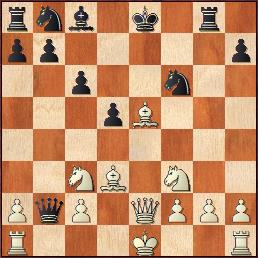 |
(4) LateLoyalBagel (1262) - BestMiddleSun (1129) [D10]
Live Chess ChessKid.com
1.d4 d5 2.c4 c6 3.c5?! This pawn advance just comes closer to the black side, where the pawn will have little choice but to exchange itself after advancing two moves. 3...b6 4.cxb6 Qxb6 [4...axb6! opens the file for the rook and brings the pawn to closer to the central fight.] 5.Nc3 Bf5 6.f3 Nd7?! [6...Nf6 is a developing move that stops White from advancing in the center with the e-pawn.] 7.e4! Bg6 8.e5?! This opens the diagonal for the black bishop on g6. Better to win a pawn with [8.exd5] 8...e6 9.Nge2 Bb4 10.g3 Ne7 11.Nf4? Bf5?! [11...Nf5! Causes a lot of trouble as it is difficult for White to guard the d-pawn.] 12.g4 Bg6 13.Nxg6 Nxg6 14.Bd3? Nf4?
 |
NEW: US Chess Online Rated Tournaments
Twice a month
August 9, 15, 23, 30 @ 3PM on chesskid.com
https://www.milibrary.org/chess-tournaments/uscf-online-rated-scholastic-tournaments-chesskidcom
US Chess online rated - affecting online rapid rating - every player must be a US Chess member
Trophies or Medals for Top Finishers
Convenient, safe platform & tight fair play screening
Space is limited to first 30 players to ensure tournament quality
Virtual Summer Chess Camps 2020
More information: https://www.milibrary.org/chess/scholastic-chess#camps
Register: https://mechanics-institute.jumbula.com/2020OnlineClasses_120/VirtualSummerCamp
9AM - 12AM morning camps: Monday through Fridays
Next camp: August 10-14 - camp is filling up so secure your spot now!
Min 4 students, max 9 students in each camp.
Continuing our Small Group Afternoon Chess Classes
More information: https://www.milibrary.org/chess/scholastic-chess#online%20classes
1-hour intensive class followed by optional online tournament
$25/class, $45/two classes or $80/four classes package
Available classes:
Monday 4:00-5:00PM - Coach Colin
Tuesday 3:15-4:15PM - Coach Andy
Friday 2:00-3:00PM - Coach Andy
If you have any questions, or need a sample of a class, please feel free to reach out to [email protected].
Mechanics' Institute Online Events Schedule
The Mechanics' Institute Chess Club will continue to hold regular online events in various forms. Here is the upcoming schedule for players:
Format: 5SS G/8+2
Join from 6PM - https://www.chess.com/live#t=1493270
Start at 7PM
Past Club Tournament results are here:
Any questions? [email protected]
FM Paul Whitehead
The King March, Part 2: Tigran Petrosian.
Playing at Lone Pine in 1978 was an incredible experience for me. Taking clear first place was the legendary Bent Larsen, with 7.5 from 9 games - a Lone Pine record score. More peaceably inclined was another chess immortal pushing wood in the tournament: World Champion Tigran Petrosian. His six points came from three victories and six draws.
Just being in the presence of these players, watching them play and analyze the moves, was a chess education like no other. I was particularly impressed with Petrosian – it seemed to me, watching him go over his games afterwards, that his thinking was different than the other players. It was my impression that individual moves didn’t seem to interest him. There was none of that plunking a move down and then taking a look around kind of thing that I was used to. Instead he would run off long strings of moves – stuff that he’d seen during the game perhaps, or new ideas.
It seemed imaginative and spontaneous – and for me it was like watching a jazz musician.
However that may be, it was Larsen (and others) that I found myself having dinner with one evening at one of those typical cafeterias dotting the Western landscape. Meatloaf and malted milk. I remember Alan Benson was there, but I can’t recall anyone else. Larsen was sitting across from me. Seeing a chance to satisfy my curiosity, I asked the Great Dane a question: Why, with both he and Petrosian claiming Aron Nimzovitch (1886-1935) as a major influence, was their play so different from each other’s? Larsen’s reply was quick and witty, salted with the confidence with which he was so well-known:
“I am the attacking Nimzovitch,” he chuckled. “Petrosian is the defensive Nimzovitch.”
It was an amazing moment.
---------------------------------------------------------------------------------------------------------------------
Looking around in Nimzovitch’s Chess Praxis (1929) we find this game the Latvian/Danish wizard played against Cohn. Along with the accompanying chapter on Nimzovitch’s theory of “alternation” – attacking weaknesses in a rotating fashion – this game features a very long king march starting with 68…Kg7.
I think this rather odd and very long game must have made a deep impression on the Armenian genius in his early days.
Cohn-Nimzovitch 1911.
1.d4 d5 2.Nf3 e6 3.c4 c5 4.e3 Nf6 5.Bd3 Bd6 6.O-O O-O 7.a3 cxd4 8.exd4 dxc4 9.Bxc4 Nc6 10.Nc3 b6 11.Bg5 Bb7 12.Qe2 h6 13.Be3 Ne7 14.Ne5 Ned5 15.Nxd5 Nxd5 16.Qh5 Bxe5 17.Qxe5 Nf6 18.Rfe1 Bd5 19.Bd3 Rc8 20.Rac1 Ng4 21.Qg3 Nxe3 22.fxe3 Qd7 23.Ba6 Rxc1 24.Rxc1 Qa4 25.Bf1 Qb3 26.Qf2 f5 27.Qd2 Rf7 28.Qc3 Qa4 29.g3 Kh7 30.Bg2 Qb5 31.Bxd5 exd5 32.Qd2 Qb3 33.Qc3 Qb5 34.Qd2 Qb3 35.Qc3 Qb5 36.Qd2 Re7 37.Qc2 Qd7 38.Qd3 Re4 39.Kf2 Qe6 40.Rf1 Qg6 41.Kg2 Qe6 42.Kf2 Qg6 43.Kg2 Qe6 44.Kf2 Kg6 45.Rc1 Kh7 46.Rc2 Qg6 47.Kg2 Qg5 48.Rf2 Qg6 49.Qe2 Qe6 50.Qf3 Kg6 51.Re2 Kh7 52.Kf2 Qc8 53.Kg2 Qe6 54.Kf2 Qg6 55.Kg2 Qg5 56.Kf2 Qf6 57.Kg2 Qg5 58.Kf2 Qg6 59.Kg2 Qe6 60.Kf2 Qc8 61.Kg2 Qe6 62.Kf2 Qc8 63.Kg2 a5 64.h4 Kg6 65.Kh2 h5 66.Kg2 Kh6 67.Rf2 g6 68.Rf1.

68…Kg7 69.Rf2 Kf7 70.Kh2 Ke7 71.Re2 Qc1 72.Qf2 Kd7 73.Re1 Qc6 74.Kg2 Rg4 75.Rf1 Qc7 76.Qf3 Kc8 77.Qf2 Kb8 78.Kh3 Ka7 79.Rg1 Qd7 80.Kh2 Qd6 81.Kh3 Qc6 82.Re1 Qe6 83.Kh2 Qe4 84.Kh3 Qe6 85.Kh2 Qe7 86.Kh3 Qe4 87.Rg1 Qe6 88.Kh2 Re4 89.Rc1 Rxe3 90.Qf4 Re2+ 91.Kh3 Ka6 92.b4 axb4 93.axb4 Kb5 94.Rc7 Qe4 95.Qxe4 Rxe4 96.Rg7 Re6 97.Rd7 Kc4 98.Kg2 Kxd4 99.Kf3 Kc4 100.b5 d4.
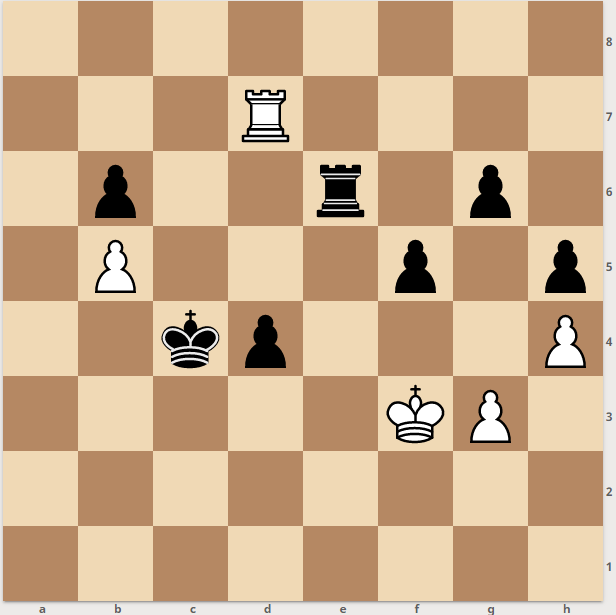
White resigned.
---------------------------------------------------------------------------------------------------------------------
Petrosian seemed to have a unique relationship with the king, sometimes bordering on the unexplainable. How can we mere mortals understand a move like 17.Kh1?
Petrosian-Kuzmin 1973.
1. c4 Nf6 2. d4 e6 3. Nc3 Bb4 4. e3 c5 5. Bd3 O-O 6. Nf3 d5 7. O-O dxc4 8. Bxc4 a6 9. a3 Ba5 10. dxc5 Bxc3 11. bxc3 Qa5 12. a4 Nbd7 13. c6 bxc6 14. Qc2 c5 15. e4 Qc7 16. Re1 Ng4.

17. Kh1 Re8 18. h3 Ngf6 19. e5 Nd5 20. Ng5 Nf8 21. f4 Bb7 22. Ne4 Ng6 23. Qf2 Nb6 24. Bf1 Bxe4 25. Rxe4 Qc6 26. Qc2 Nd5 27. a5 Red8 28. Kh2 Rab8 29. Rea4 Nge7 30. Bd3 Nf5 31.Bxf5 exf5 32. Qxf5 Nxc3 33. Rc4.
Drawn.
---------------------------------------------------------------------------------------------------------------------
In the following two games we see essentially the same strategy. Petrosian removes his king to the safety of the queenside in order to attack on the kingside. It’s the journey of a 1,000 years, and Petrosian’s grip on the narrative is incredible.
Petrosian-Unzicker 1960.
1. d4 Nf6 2. Nf3 e6 3. Bg5 d5 4. c4 c6 5. Qc2 Be7 6. e3 O-O 7.Nc3 h6 8. Bf4 Nbd7 9. cxd5 10. Bd3 a6 11. O-O b5 12. a4 b4 13. Na2 Ne8 14. Nc1 a5 15. Nb3 Ba6 16. Bxa6 Rxa6
17. Qd3 Ra7 18. Rfc1 Nd6 19. Bxd6 20. Rc6 Nb8 21. Rc2 Nd7 22. Rac1 Nb6 23. Qb5 Nc4 24. Nfd2 Nxd2 25. Rxd2 Qa8 26. Rdc2 Rd8 27. Rc6 g6 28. g3 Kg7.

29. Kf1 Kf8 30. h4 h5 31. R1c2 Kg7 32. Ke1 Kg8 33. Kd1 Kh7 34. Kc1 Kg8 35. Kb1 Kh7 36. Qe2 Qb7 37. Rc1 Kg7 38. Qb5 Qa8 39. f4 Kh7 40. Qe2 Qb7.

41. g4 hxg4 42. Qxg4 Qe7 43. h5 Qf6 44. Ka2 Kg7 45. hxg6 Qxg6 46. Qh4 Be7 47. Qf2 Kf8 48. Nd2 Rb7 49. Nb3 Ra7 50. Qh2 Bf6 51. Rc8 Rd7 52. Nc5 b3+ 53. Kxb3 Rd6 54. f5 Rb6+ 55. Ka2.

Black resigned.
---------------------------------------------------------------------------------------------------------------------
This masterpiece is from Petrosian’s first visit to Lone Pine, which he won with 5.5 from 7 games. It closely resembles the win over Unzicker 16 years earlier, I think.
Petrosian-Peters 1976.
1. c4 Nf6 2. Nc3 c5 3. g3 Nc6 4. Bg2 e6 5. Nf3 Be7 6. d4 d5 7. cxd5 Nxd5 8. O-O 9. Nxd5 exd5 10. dxc5 Bxc5 11. a3 a5 12. Ne1 d4 13. Nd3 Bb6 14. Bd2 Re8 15. Rc1 Bg4 16. Re1 Rc8
17. h3 Bf5 18. Qb3 Be4 19. Bxe4 Rxe4 20. Qb5 Na7 21. Rxc8 Nxc8 22. Bg5 Qd6 23. Rc1 Na7 24. Qf5 Re8 25. Bf4 Qd8 26. Rc2 Nc6 27. h4 h6 28. Qb5 Na7 29. Qf5 Nc6.

30. Kf1 Re6 31. Qb5 Na7 32. Qb3 Nc6 33. h5 Ne7 34. Ke1 Nd5 35. Qb5 Nf6 36. Kd1 Nd5
37. Be5 Ne7 38. g4 Nc6 39. Bg3 Na7 40. Qb3 Nc6 41. Kc1 Re4 42. f3 Re3 43. Kb1.

43…Ne7 44. Bh4 Qd6 45. Bxe7 Rxe7 46. Rc8+ Kh7 47. Rf8 Qc7 48. f4 Bc5 49. Qd5 Re5 50. Rxf7.
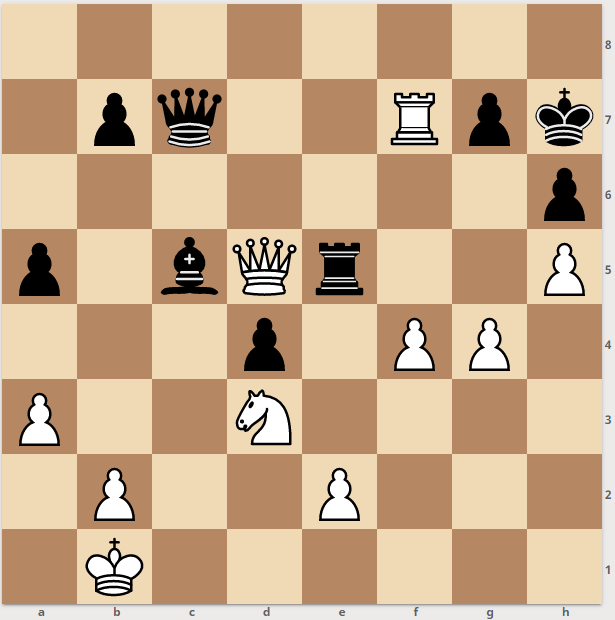
Black resigned.
---------------------------------------------------------------------------------------------------------------------
Petrosian’s most famous king march might be this one, from his World Championship Match with Botvinnik. The white king infiltrates and paralyzes the black forces.
Petrosian-Botvinnik 1963.
1.c4 g6 2.d4 Nf6 3.Nc3 d5 4.Nf3 Bg7 5.e3 O-O 6.Be2 dxc4 7.Bxc4 c5 8.d5 e6 9.dxe6 Qxd1+ 10.Kxd1 Bxe6 11.Bxe6 fxe6 12.Ke2 Nc6 13.Rd1 Rad8 14.Rxd8 Rxd8 15.Ng5 Re8 16.Nge4 Nxe4 17.Nxe4 b6 18.Rb1 Nb4 19.Bd2 Nd5 20.a4 Rc8 21.b3 Bf8 22.Rc1 Be7 23.b4 c4
24.b5 Kf7 25.Bc3 Ba3 26.Rc2 Nxc3+ 27.Rxc3 Bb4 28.Rc2 Ke7 29.Nd2 c3 30.Ne4 Ba5.

31.Kd3 Rd8+ 32.Kc4 Rd1 33.Nxc3 Rh1 34.Ne4 Rxh2 35.Kd4 Kd7 36.g3 Bb4 37.Ke5 Rh5+ 38.Kf6 Be7+ 39.Kg7.

39…e5 40.Rc6 Rh1 41.Kf7 Ra1 42.Re6 Bd8 43.Rd6+ Kc8 44.Ke8 Bc7 45.Rc6
Rd1 46.Ng5 Rd8+ 47.Kf7 Rd7+ 48.Kg8.

Black resigned.
---------------------------------------------------------------------------------------------------------------------
Along similar lines is this take-down of the Brazilian ace Henrique Mecking:
Petrosian-Mecking 1971.
1.d4 Nf6 2.Nf3 e6 3.Bg5 c5 4.e3 d5 5.c3 Nc6 6.Nbd2 cxd4 7.exd4 Be7 8.Bd3 h6 9.Bf4 Nh5 10.Be3 Nf6 11.Ne5 Nxe5 12.dxe5 Nd7 13.Bd4 Nc5 14.Bc2 a5 15.Qg4 g6 16.O-O Bd7 17.Rfe1 Qc7 18.a4 Na6 19.Qe2 Kf8 20.Nf3 Kg7 21.Be3 Nc5 22.Nd4 Ra6 23.Bc1 Raa8
24.g3 b6 25.h4 h5 26.Qf3 Qd8 27.Bd2 Qe8 28.Bg5 Qd8 29.Qf4 Rc8 30.Re3 Bxg5 31.hxg5 Ra8 32.Qf6+ Qxf6 33.exf6+ Kh7.
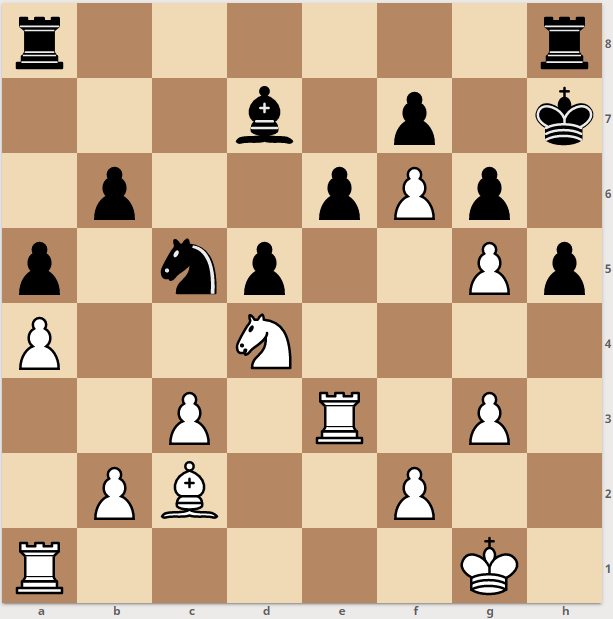
34.Kg2 Rae8 35.f4 Rb8 36.Ree1 Nb7 37.Rh1 Kg8 38.Nf3 Nd6 39.Ne5 Be8 40.Bd3 Rc8 41.Kf3 Bc6 42.Rh2 Be8 43.Ke3 Rc7 44.Kd4.
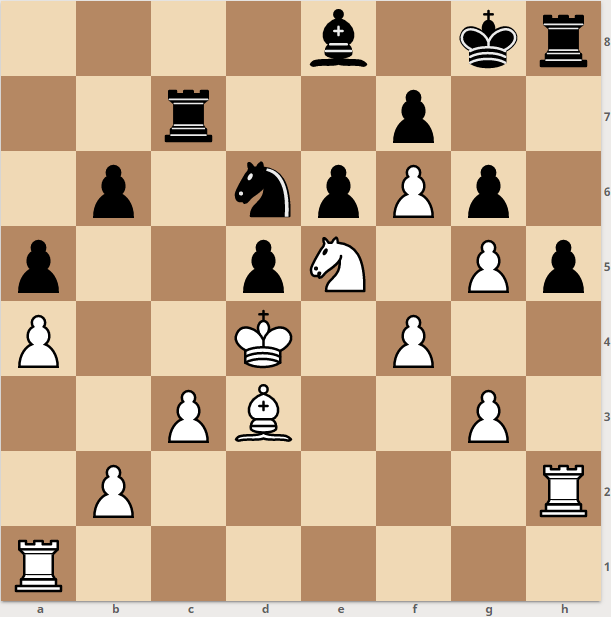
44…Nb7 45.b4 Nd8 46.Rh4 Nb7 47.Ra2 Nd6 48.Rh1 Nb7 49.b5 Nc5 50.Bc2 Nd7 51.Ra3 Nc5 52.c4 Nd7 53.Rc3 Nxe5 54.Kxe5 dxc4 55.Be4 Rc8 56.Kd6 Rc5 57.Rhc1.
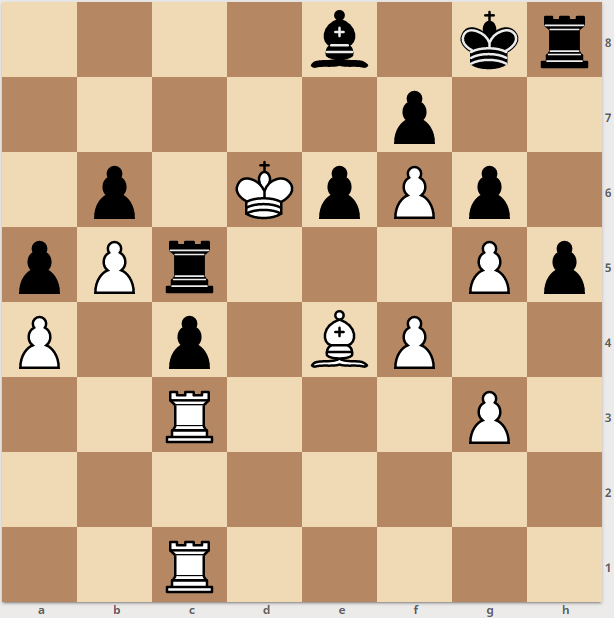
Black resigned.
---------------------------------------------------------------------------------------------------------------------
Petrosian not only used the king march as an attacking weapon, in his own imitable way - he was perhaps the first player to use it comprehensively as a defensive strategy. The following three examples I think are extraordinary in the long and crazy annals of king marches.
---------------------------------------------------------------------------------------------------------------------
Here, against the young Bobby Fischer, Petrosian shows no fear in the combined white forces of queen, rook and bishop.
Fischer-Petrosian 1959.
1. e4 c6 2. Nc3 d5 3. Nf3 Bg4 4. h3 Bxf3 5. Qxf3 Nf6 6. d3 e6 7. g3 Bb4 8. Bd2 d4 9. Nb1 Bxd2+ 10. Nxd2 e5 11. Bg2 c5 12. O-O Nc6 13. Qe2 g5 14. Nf3 h6 15. h4 Rg8 16. a3 Qe7
17. hxg5 18. Qd2 Nd7 19. c3 O-O-O 20. cxd4 exd4 21. b4 Kb8 22. Rfc1 Nce5 23. Nxe5 Qxe5 24. Rc4 Rc8 25. Rac1 g4 26. Qb2 Rgd8 27. a4 Qe7 28. Rb1 Ne5 29. Rxc5 30. bxc5 Nxd3 31. Qd2 Nxc5 32. Qf4+ Qc7 33. Qxg4 Nxa4 34. e5 Nc5 35. Qf3 d3 36. Qe3 d2 37. Bf3 Na4 38. Qe4 Nc5 39. Qe2 a6 40. Kg2.
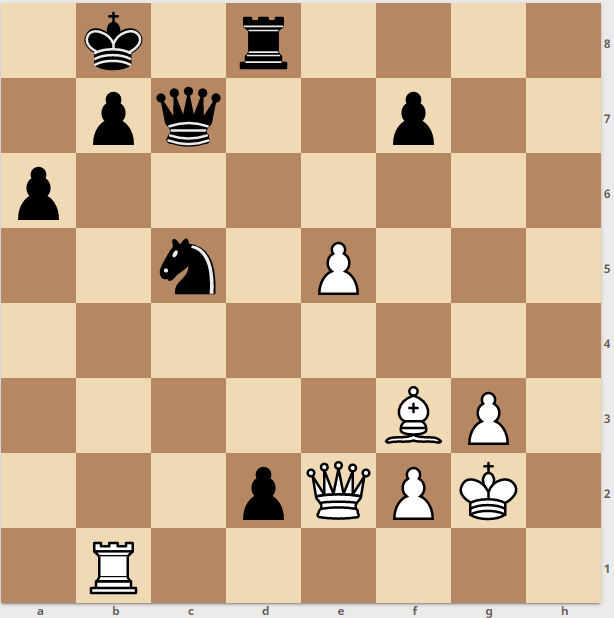
40… Ka7 41. Qe3 Rd3 42. Qf4 Qd7 43. Qc4 b6 44. Rd1 a5 45. Qf4 Rd4 46. Qh6 b5 47. Qe3 Kb6 48. Qh6+ Ne6 49. Qe3 Ka6 50. Be2 a4 51. Qc3 Kb6 52. Qe3 Nc5 53. Bf3 b4 54. Qh6+ Ne6 55. Qh8 Qd8 56. Qh7 Qd7 57. Qh8 b3 58. Qb8+ Ka5 59. Qa8+ Kb5 60. Qb8+.

60… Kc4 61. Qg8 Kc3 62. Bh5 Nd8 63. Bf3 a3 64. Qf8 Kb2 65. Qh8 Ne6 66. Qa8 a2 67. Qa5 Qa4 68. Rxd2+ Ka3.

White resigned.
---------------------------------------------------------------------------------------------------------------------
This game features the king march to end all king marches, as Petrosian’s king runs into danger and then back to safety in a baffling display of chess genius. Again, the combined forces of queen, rook and bishop are strangely impotent.
Cardoso-Petrosian 1975.
1. e4 c5 2. Nf3 e6 3. d4 cxd4 4. Nxd4 Nf6 5. Nc3 d6 6. g4 a6 7. g5 Nfd7 8. h4 b5 9. Bg2 Bb7 10. h5 Nc6 11. a3 Rc8 12. Rh3 Nxd4 13. Qxd4 Rc4 14. Qe3 Be7 15. f4 e5 16. f5 h6 17. g6 fxg6 18. hxg6 Nf6 19. Bd2 Qa8 20. O-O-O Nxe4 21. Bxe4 22. b3 Rd4 23. f6 Bxf6 24. Re1 d5 25. Nxe4 Rxe4 26. Qc5 Rxe1+ 27. Bxe1.

27… Kd7 28. Bb4 Qc6 29. Qa7+ Ke6 30. Rg3 e4 31. Qf7+ Ke5 32. Rc3 Qe6 33. Rc7 Kf5 34. Rd7 Re8 35. Rd6 Qc8 36. Rxd5+ Kg4 37. Rd1 Qe6 38. Rg1+ Kh3.
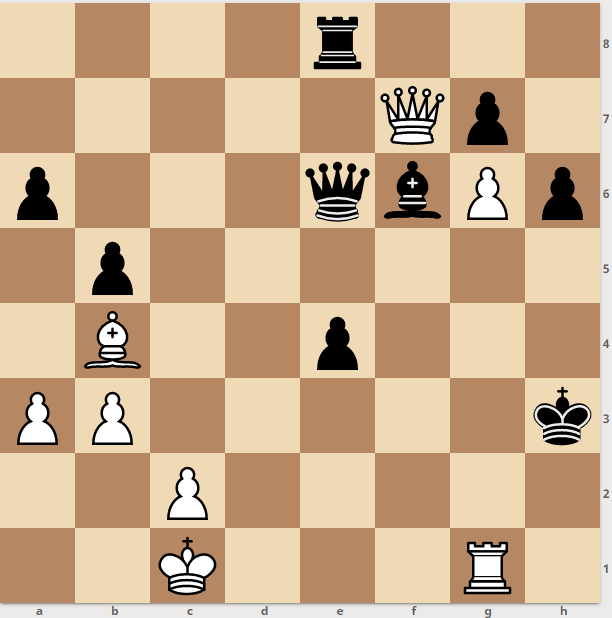
39. Qa7 e3 40. Qb7 Qe4 41. Qd7+ Re6 42. Qd1 e2 43. Qe1 Qe5 44. Rh1+ Kg4 45. Qg1+ Kf5 46. Qf2+ Kxg6 47. Rg1+ Kf7 48. Re1 Kg8 49. Kd2 Bg5+ 50. Kd3 Qd5+.

White resigned.
Finally, another Houdini-like escape. Using his patented bold king formula, the wily old fox confounds the one and only Garry Kasparov in his attacking prime. Black’s 35th move has “Tigran Petrosian” stamped all over it.
Kasparov-Petrosian 1981.
1.d4 d5 2.c4 dxc4 3.Nf3 Nf6 4.e3 Bg4 5.Bxc4 e6 6.h3 Bh5 7.Nc3 a6 8.g4 Bg6 9.Ne5 Nbd7 10.Nxg6 hxg6 11.Bf1 c6 12.Bg2 Qc7 13.O-O Be7 14.f4 Nb6 15.g5 Nfd7 16.Qg4 O-O-O 17.Rb1 Kb8 18.b4 Nd5 19.Na4 f5 20.Qg3 Nxb4 21.Bd2 Nd5 22.Rfc1 Ka7 23.Qe1 Ba3
24.Rc2 Qd6 25.Rb3 Qe7 26.Qe2 Rb8 27.Qd3 Bd6 28.Nb2 Rhc8 29.Nc4 Bc7 30.a4 b5 31.axb5 cxb5 32.Ra2 Kb7 33.Bb4 Qe8 34.Bd6 Ra8 35.Qb1.

35…Kc6 36.Rba3 bxc4 37.Rxa6+ Rxa6 38.Rxa6+ Bb6 39.Bc5 Qd8 40.Qa1 Nxc5 41.dxc5 Kxc5 42.Ra4.

White resigned.
---------------------------------------------------------------------------------------------------------------------
GM Nick de Firmian's Column
Legends of Chess
The Magnus Carlsen Chess Tour continued with another high profile and entertaining event. The “Legends of Chess” tournament, sponsored by Chess 24 had the greats of the near past – Kramnik, Anand, Gelfand, Ivanchuk, Leko and Svidler – competing with the top players of today, Magnus himself, Anish Giri, Ding Liren and Ian Nempomniatchi. The preliminaries produced the four semi-finalists, which saw three of today’s top players (Giri, Nepomniatchi and Magnus) qualify and only one of the “legends” (Svidler). It’s notable that chess players very rarely stay at the top nowadays after the age of 40.
Magnus cruised through the event as he always seems to do. He had an easy time qualifying, an easy time in the semi-finals against Svidler, and an even easier time in the finals against Nepomniatchi. It’s hardly news to report Magnus winning. Yet the games we give below show the greatness of the other players too. Nepomniatchi lost badly to Magnus but produced the most entertaining game with his single victory in the finals. Svidler is no longer in the top ten, but I couldn’t resist giving his victory against Magnus when Svidler was in the top 5 and Magnus just rising (the years that made Svidler a legend). This game was played on the arctic island of Svalbard in a special match where GM Simon Agdestein and your author were also participants.
(1) Carlsen,Magnus - Svidler,Peter [B84]
Legends of Chess Semi-final, 31.07.2020
1.e4 c5 2.Nf3 d6 3.d4 cxd4 4.Nxd4 Nf6 5.Nc3 a6 A classic (almost old school) Najdorf Sicilian. 6.Be3 e6 7.Be2 Magnus develops classically as Karpov used to do. He has a more aggressive plan in mind though as Karpov would castle kingside and steer for safer play. 7...Qc7 8.Qd2 b5 9.a3 Bb7 10.f3 Nbd7 11.0-0-0! Magnus is looking for a real fight right from the start. The tactics will begin quickly with this set up. 11...d5!? Svidler makes this principled center break while he can, although he is not all developed yet. If he waits a move with [11...Be7 12.g4 Then ...d5 is hard to achieve because of g4-g5,] 12.exd5 Bxd5 13.Bf4! Qb6 [not 13...e5? 14.Nxd5 Nxd5 15.Nxb5 axb5 16.Qxd5 Rc8 17.Qe4] 14.Rhe1 0-0-0? The black king just isn't safe over here. Svidler needed to counterattack with [14...b4 15.Nxd5 Nxd5 though White could keep an edge with 16.a4 and have the safer king.] 15.Be3 Qb7
 |
(2) Svidler,Peter (2742) - Carlsen,Magnus (2675) [B30]
Longyearbyen m Longyearbyen (2), 02.09.2006
1.e4 c5 2.Nf3 Nc6 3.Nc3 Nf6 4.Bb5 A reasonable alternative to the open Sicilian of 4. d4, upon which Magnus would play the Sveshnikov Variation. 4...Qc7 5.0-0 Nd4 6.Nxd4 cxd4 7.Nd5 Nxd5 8.exd5 a6 [8...Qc5 9.Qe2 Qxd5 10.Bc4 Qc6 11.b3 is reasonable play for the pawn] 9.Ba4 g6 This logical developing move is a bit slow in this position. [9...e6 is more direct in the center] 10.d3 h6?! Magnus was a teenager at this time. His move prevents 11. Bg5 but loses valuable time - a mistake he would not make nowadays. 11.Qf3 Bg7 12.Bf4 Qa5
 |
 |
(3) Nepomniatchi,Ian - Carlsen,Magnus [B90]
Legends of Chess, 03.08.2020
1.e4 c5 2.Nf3 d6 3.d4 cxd4 4.Nxd4 Nf6 5.Nc3 a6 6.Rg1!? This strange looking move has the point of playing for g4 along the lines of an English or Keres Attack. The move has been played many times by now but is still regarded as an unusual sideline against the Najdorf. 6...b5 7.g4 Bb7 8.g5!? Nepo makes this creative pawn sacrifice, which is very confusing to meet. 8...Nxe4 9.Nxe4 Bxe4 10.a4! Now play ranges over the entire board. 10...e5 The computer likes keeping things closed with [10...b4] 11.axb5!
 |
 |
20...gxh5 21.Qxh5 White is a rook down but his pieces control the key kingside squares. The white attack cannot be stopped. 21...Ne6 Magnus lost on time, but he is finished. e.g. 22.g6 fxg6 23.Qxg6+ Kh8 24.Qh6+ Kg8 25.Qxe6+ Rf7 26.Nh6+ Kg7 27.Qxf7+ Kh8 28.Bd3 1-0
Submit your piece or feedback
We would welcome any feedback, articles or "Letter to the Editor" piece. Submit yours today through this Google Form:
https://forms.gle/eLfUyg2yFZ3vxgcMA
You can browse through our archived newsletters using the "next" and "previous buttons".
Want to save this newsletter for reading at a later time? Click here to learn how.
Want to be notified when the next newsletter is published? Join Our Email List →
